San Diego, California, Hgh State Clinic, Hgh Injections, Hrt Doctors
San Diego, California Blood Testing Facilities
 Represents a LabCorp blood testing facility
Represents a LabCorp blood testing facility Represents a Quest Diagnostics blood testing facility
Represents a Quest Diagnostics blood testing facility

Nearby Labcorp Blood Testing facilities:
- Labcorp Center Distance: 2 m, 4060 4Th Ave. Ste 105, San Diego, San Diego County, CA, 92103
- Labcorp Center Distance: 4 m, 1037 Highland Avenue, National City, San Diego County, CA, 91950
- Labcorp Center Distance: 6 m, 450 4Th Ave. Suite 405, Chula Vista, San Diego County, CA, 91910
- Labcorp Center Distance: 7 m, 3737 Moraga Ave. Suite A204, San Diego, San Diego County, CA, 92117
- Labcorp Center Distance: 10 m, 7300 Girard Ave Ste 105, La Jolla, San Diego County, CA, 92037
- Labcorp Center Distance: 12 m, 8901 Activity Rd. Suite 201, San Diego, San Diego County, CA, 92126
- Labcorp Center Distance: 15 m, 1625 E Main St Ste 203, El Cajon, San Diego County, CA, 92021
- Labcorp Center Distance: 20 m, 15721F Bernardo Heights Pkwy, San Diego, San Diego County, CA, 92128
- Labcorp Center Distance: 23 m, 351 Santa Fe Dr Ste 210, Encinitas, San Diego County, CA, 92024
- Labcorp Center Distance: 24 m, 345 Saxony Rd Ste 201B, Encinitas, San Diego County, CA, 92024
- Labcorp Center Distance: 27 m, 1955 Citracado Pkwy Suite 103, Escondido, San Diego County, CA, 92029
- Labcorp Center Distance: 28 m, 629 East Grand Ave, Escondido, San Diego County, CA, 92025
- Labcorp Center Distance: 29 m, 1595 Grand Ave Ste 109, San Marcos, San Diego County, CA, 92078
- Labcorp Center Distance: 33 m, 2067 West Vista Way Suite 275, Vista, San Diego County, CA, 92083
- Labcorp Center Distance: 46 m, 587 E. Elder Street, Fallbrook, San Diego County, CA, 92028
- Labcorp Center Distance: 52 m, 31150 Temecula Parkway Ste 201, Temecula, Riverside County, CA, 92592
- Labcorp Center Distance: 55 m, 27699 Jefferson Ave Ste 209, Temecula, Riverside County, CA, 92590
- Labcorp Center Distance: 58 m, 25405 Hancock Ave. Suite 107, Murrieta, Riverside County, CA, 92562
- Labcorp Center Distance: 60 m, 36320 Inland Valley Dr Ste 103, Wildomar, Riverside County, CA, 92595
- Labcorp Center Distance: 65 m, 26691 Plaza Drive Suite 180, Mission Viejo, Orange County, CA, 92691
- Labcorp Center Distance: 66 m, 31571 Canyon Estates Dr Ste101, Lake Elsinore, Riverside County, CA, 92532
- Labcorp Center Distance: 67 m, 29798 Haun Rd Ste 102, Menifee, Riverside County, CA, 92586
- Labcorp Center Distance: 69 m, 29873 Santa Margarita Pkwy102, Rancho Santa Margarita, Orange County, CA, 92688
- Labcorp Center Distance: 72 m, 850 E. Latham Ave. Ste Cd, Hemet, Riverside County, CA, 92544
- Labcorp Center Distance: 74 m, 400 Newport Center Dr Ste 202, Newport Beach, Orange County, CA, 92660
- Labcorp Center Distance: 75 m, 126 Avocado Ave. Ste 105, Perris, Riverside County, CA, 92571
- Labcorp Center Distance: 76 m, 4870 Barranca Pkwy. Ste 290, Irvine, Orange County, CA, 92604
- Labcorp Center Distance: 77 m, 1501 Superior Ave. Ste 209, Newport Beach, Orange County, CA, 92663
- Labcorp Center Distance: 81 m, 100 N. Tustin Avenue, Tustin, Orange County, CA, 92780
- Labcorp Center Distance: 82 m, 73345 Highway 111 Suite 204B, Palm Desert, Riverside County, CA, 92260
- Labcorp Center Distance: 83 m, 900 S. Main St. Suite 207, Corona, Riverside County, CA, 92882
- Labcorp Center Distance: 84 m, 72780 Country Club Drive 303C, Rancho Mirage, Riverside County, CA, 92270
- Labcorp Center Distance: 85 m, 3975 Jackson St. Ste 104, Riverside, Riverside County, CA, 92503
- Labcorp Center Distance: 86 m, 6927 Brockton Ave Ste 1B, Riverside, Riverside County, CA, 92506
- Labcorp Center Distance: 87 m, 10420 Beaumont Ave. Suite G, Cherry Valley, Riverside County, CA, 92223
- Labcorp Center Distance: 89 m, 1190 Pacific Coast Hwy Ste C, Seal Beach, Orange County, CA, 90740
- Labcorp Center Distance: 90 m, 1661 Golden Rain Rd, Seal Beach, Orange County, CA, 90740
- Labcorp Center Distance: 91 m, 34845 Yucaipa Bl. Ste B, Yucaipa, San Bernardino County, CA, 92399
- Labcorp Center Distance: 92 m, 1950 Sunnycrest Dr. Suite 1800, Fullerton, Orange County, CA, 92835
- Labcorp Center Distance: 93 m, 1703 Termino Ave Ste 102, Long Beach, Los Angeles County, CA, 90804
- Labcorp Center Distance: 95 m, 12555 Central Ave. Ste Af, Chino, San Bernardino County, CA, 91710
- Labcorp Center Distance: 96 m, 2690 Pacific Ave. Suite 330, Long Beach, Los Angeles County, CA, 90806
- Labcorp Center Distance: 97 m, 1360 W 6Th St Ste 190, San Pedro, Los Angeles County, CA, 90732
- Labcorp Center Distance: 98 m, 399 E. Highland Ave. Ste 510, San Bernardino, San Bernardino County, CA, 92404
- Labcorp Center Distance: 99 m, 1310 San Bernardino Rd Ste 107, Upland, San Bernardino County, CA, 91786
Nearby Quest Blood Testing facilities:
- Quest Center Distance: 7 m, 480 4Th Ave, Chula Vista, San Diego County, CA, 91910-4411
- Quest Center Distance: 9 m, 5103 Garfield St, La Mesa, San Diego County, CA, 91941-5103
- Quest Center Distance: 24 m, 477 N El Camino Real, Encinitas, San Diego County, CA, 92024-1353
- Quest Center Distance: 33 m, 3601 Vista Way, Oceanside, San Diego County, CA, 92056-4559
- Quest Center Distance: 55 m, 27699 Jefferson Ave, Temecula, Riverside County, CA, 92590-2696
- Quest Center Distance: 65 m, 32251 Mission Trl, Lake Elsinore, Riverside County, CA, 92530-4536
- Quest Center Distance: 69 m, 23521 Paseo De Valencia, Laguna Hills, Orange County, CA, 92653-3673
- Quest Center Distance: 75 m, 4950 Barranca Pkwy, Irvine, Orange County, CA, 92604-8648
- Quest Center Distance: 81 m, 801 N Tustin Ave, Santa Ana, Orange County, CA, 92705-3607
- Quest Center Distance: 82 m, 2250 S. Main St, Corona, Riverside County, CA, 92882-2534
- Quest Center Distance: 83 m, 118 W 9Th St, Corona, Riverside County, CA, 92882-3320
- Quest Center Distance: 84 m, 6485 Day St, Riverside, Riverside County, CA, 92507-0926
- Quest Center Distance: 85 m, 9041 Magnolia Ave, Riverside, Riverside County, CA, 92503-3956
- Quest Center Distance: 86 m, 81715 Dr Carreon Blvd, Indio, Riverside County, CA, 92201-5564
- Quest Center Distance: 88 m, 4646 Brockton Ave, Riverside, Riverside County, CA, 92506-0103
- Quest Center Distance: 92 m, 1635 W Main St, El Centro, Imperial County, CA, 92243-2212
- Quest Center Distance: 94 m, 4028 Grand Ave, Chino, San Bernardino County, CA, 91710-5486
- Quest Center Distance: 97 m, 1294 W 6Th St, San Pedro, Los Angeles County, CA, 90731-2998
- Quest Center Distance: 98 m, 2150 N Waterman Ave, San Bernardino, San Bernardino County, CA, 92404-4811
San Diego Hormone Replacement Therapy Services
Have you ever considered Hormone Replacement or Hormone Optimization? Hormone Balance is one of the single most important aspects of human health, and there are a lot of ways that our bodies simply get out of tune, whether as a result of lifestyle factors, genetics, or simply as a result of aging. The Conscious Evolution Institute is dedicated to providing patients in the San Diego Area with the best Hormone Replacement Treatments available in the United States.
We have affiliate medical professionals located all throughout the San Diego Area that are highly trained and experienced in Hormone Replacement Therapy Protocols, and they can provide you with the preliminary testing needed to find out if you qualify for HGH, Testosterone, or other forms of Hormone Therapy.
Our physicians are licensed and board certified clinical pros that can provide you with the highest quality care for an affordable price. We work with Online Pharmacies that specialize in Hormone Treatment, and we can provide these HRT Products and services at the most competitive price on the market. If you feel that you may be a candidate for Hormone Replacement Therapy or state of the art Hormone Treatments, we encourage you to fill out the contact form on this page, or call us at the number listed at the top of the page! We serve patients over the age of thirty, with a diagnosed clinical need for treatment.
San Diego Testosterone Therapy for Andropause and Low-T
Testosterone is the quintessential male hormone. Testosterone supports male health and vitality in a huge variety of ways. Sadly, however, Testosterone Deficiency can become a major issue for men as they grow older, preventing them from maintaining their physical, psychological, and sexual vigor. Testosterone Therapy is a clinically proven method to effectively treat Testosterone Deficiency, and millions of men across the nation and even more across the globe have experienced the rejuvenating effects of Testosterone Treatments.
Our clinic offers a variety of Testosterone Therapy options. If you are interested in Testosterone Gels, Creams, or Injections, we can deliver them directly to your address. Also ask about alternative treatment options such as Clomiphene Citrate, and other ancillary options such as Estrogen Blockers which have the capability of enhancing the effectiveness of treatment for many patients.
San Diego HGH Injections for Growth Hormone Imbalance
Human Growth Hormone is one of the most important hormones that the human body makes, and perhaps the most important with regard to cellular metabolism and self-maintenance. When HGH Levels are optimal, the body functions at its best. Growth Hormone Deficiency is often an age-related condition, in which the body slowly loses its ability to produce sufficient levels of the hormone to meet the needs of the body.
HGH Deficiency can have profound symptoms that potentially impact almost all systems of the body. Human Growth Hormone Deficiency can lead to weight gain, loss of muscle mass, and progressive loss of Bone Mineral Density. The condition also weakens the effectiveness of the immune system and slows down healing and physical rehabilitation. The imbalance can also impact psychological and cognitive health, inhibiting memory, increasing the risk of depression and suppressing well-being. HGH Injections replace the Growth Hormone that the body is no longer making effectively in order to counteract symptoms of aging and premature aging that are the result of Hormone Imbalance.
San Diego Sermorelin Acetate Injection Therapy
Bio-Identical HGH Therapy is not the only option for patients with Growth Hormone Deficiency, however. The Conscious Evolution Institute also offers Sermorelin Acetate, which has the capability to relieve HGH Deficiency in many patients, with a slightly improved safety profile. Sermorelin Acetate is the functional analog of a hormone produced by the Hypothalamus known as GH-RH, which directly stimulates the production of Growth Hormone. Unlike HGH Injections, Sermorelin leaves the body in control of the release of natural Growth Hormone, which helps preserve normal function and circadian rhythm.
Sermorelin is also cheaper than Human Growth Hormone, meaning that it can fit into your budget more effectively. Finally, many patients may qualify for Sermorelin that cannot yet qualify for Bio-Identical HGH, because Sermorelin can be offered off-label if your physician feels that you can benefit from treatment.
San Diego HCG Diet for Weight Loss
For men and women that are overweight or obese, weight loss represents an imposing and difficult challenge. Some people have struggled for years and years with their weight, with a sincere desire to reach a healthier and more fit state, to no avail. Before turning to surgical options such as stomach stapling and gastric-bypass, consider HCG Therapy. Injectable HCG Therapy is a physician-mediated hormone therapy treatment designed to encourage weight loss in combination with a restrictive diet. With the HCG Diet, patients around the country have lost the weight and managed to keep it off. With the HCG Diet, it's possible to lose as much as seven pounds per week! Contact us to learn more.
San Diego Information
San Diego is one of the largest cities in California, and is located in the southwest portion of the state, immediately along the Pacific Ocean. Aside from Los Angeles, San Diego is the largest city in the state. San Diego has a large an active economy, buoyed significantly by the military and transportation presence in the city. San Diego is a major American port-city, and is the home of the largest naval fleet of the United States, and the largest permanent naval presence on earth. Because of the military presence in the city, there are a large number of defense contractors and civilian jobs that depend directly upon the military activity in the area, such as NASSCO, Cubic, and General Atomics.
In addition to its military and industrial importance, the city also has a burgeoning tourist industry, owing to its beautiful sights, active port, and its location as a gateway into Mexico, with Tijuana located immediately across the United States border. Among the tourist attractions in the city of San Diego are the San Diego Zoo, Belmont amusement park, and the Old Town San Diego State Historic Park.
San Diego is a major American sports city with two top-tier professional sports teams—The San Diego Padres and the San Diego Chargers. The San Diego State Aztecs are also a major presence in both the Division One NCAA Football and Basketball scenes.
All About San Diego, California Geographic Area
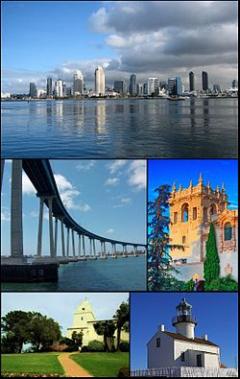
San Diego /ËusR¦n diËaËneɪɡoÊo/ is the eighth-largest city in the United States of America and second-largest city in California. The city is located on the coast of the Pacific Ocean in Southern California, immediately adjacent to the Mexican border. The birthplace of California, San Diego is known for its mild year-round climate, natural deep-water harbor, extensive beaches, long association with the U.S. Navy, and recent emergence as a healthcare and biotechnology enclave. The population was 1,301,617 at the 2010 census.
Historically home to the Kumeyaay people, San Diego was the first site visited by Europeans on what is now the West Coast of the United States. Upon landing in San Diego Bay in 1542, Juan Cabrillo claimed the entire area for Spain, forming the basis for the settlement of Alta California 200 years later. The Presidio and Mission of San Diego, founded in 1769, were the first European settlement in what is now California. In 1821, San Diego became part of newly independent Mexico, and in 1850, became part of the United States following the Mexican-American War and the admission of California to the union.
The city is the county seat of San Diego County and is the economic center of the San Diego aeCarlsbad aeSan Marcos metropolitan area as well as the San Diego aeTijuana metropolitan area. San Diego's main economic engines are military and defense-related activities, tourism, international trade, and manufacturing. The presence of the University of California, San Diego (UCSD), with the affiliated UCSD Medical Center, has helped make the area a center of research in biotechnology.

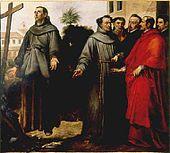
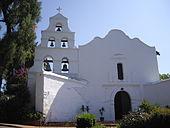
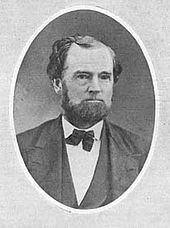
Original inhabitants of the region are now known as the San Dieguito and La Jolla people. The area of San Diego has been inhabited for more than 10,000 years by the Kumeyaay people. The first European to visit the region was Portuguese-born explorer Juan RodrRguez Cabrillo sailing under the flag of Castile. Sailing his flagship San Salvador from Navidad, New Spain, Cabrillo claimed the bay for the Spanish Empire in 1542 and named the site 'San Miguel'. In November 1602, SebastiR¡n VizcaRno was sent to map the California coast. Arriving on his flagship San Diego, VizcaRno surveyed the harbor and what are now Mission Bay and Point Loma and named the area for the Catholic Saint Didacus, a Spaniard more commonly known as San Diego de AlcalR¡. On November 12, 1602, the first Christian religious service of record in Alta California was conducted by Friar Antonio de la AscensiR³n, a member of VizcaRno's expedition, to celebrate the feast day of San Diego.
In May 1769, Gaspar de PortolRr established the Fort Presidio of San Diego on a hill near the San Diego River. In July of the same year, Mission San Diego de AlcalR¡ was founded by Franciscan friars under Father JunRpero Serra. By 1797, the mission boasted the largest native population in Alta California, with over 1,400 neophytes living in and around the mission proper. Mission San Diego was the southern anchor in California of the historic mission trail El Camino Real. Both the Presidio and the Mission are National Historic Landmarks.
In 1821, Mexico won its independence from Spain, and San Diego became part of the Mexican state of Alta California. The fort on Presidio Hill was gradually abandoned, while the town of San Diego grew up on the level land below Presidio Hill. The Mission was secularized by the Mexican government, and most of the Mission lands were distributed to wealthy Californio settlers.
As a result of the Mexican-American War of 1846 ae1848, the territory of Alta California, including San Diego, was ceded to the United States by Mexico. The Battle of San Pasqual, a battle of the Mexican-American War, was fought in 1846 in the San Pasqual Valley which is now part of the city of San Diego. The state of California was admitted to the United States in 1850. That same year San Diego was designated the seat of the newly established San Diego County and was incorporated as a city. The initial city charter was established in 1889 and today's city charter was adopted in 1931.
The original town of San Diego was located at the foot of Presidio Hill, in the area which is now Old Town San Diego State Historic Park. The location was not ideal, being several miles away from navigable water. In the late 1860s, Alonzo Horton promoted a move to "New Town", several miles south of the original settlement, in the area which became Downtown San Diego. People and businesses flocked to New Town because of its location on San Diego Bay convenient to shipping. New Town quickly eclipsed the original settlement, known to this day as Old Town, and became the economic and governmental heart of the city.
In the early part of the 20th century, San Diego hosted two World's Fairs: the Panama-California Exposition in 1915 and the California Pacific International Exposition in 1935. Both expositions were held in Balboa Park, and many of the Spanish/Baroque-style buildings that were built for those expositions remain to this day as central features of the park. The buildings were intended to be temporary structures, but most remained in continuous use until they progressively fell into disrepair. Most were eventually rebuilt, using castings of the original facades to retain the architectural style. The menagerie of exotic animals featured at the 1915 exposition provided the basis for the San Diego Zoo.
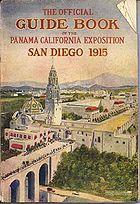
Significant U.S. Navy presence began in 1901 with the establishment of the Navy Coaling Station in Point Loma, and expanded greatly during the 1920s. By 1930 the city was host to Naval Base San Diego, Naval Training Center San Diego, San Diego Naval Hospital, Camp Matthews, and Camp Kearny (now Marine Corps Air Station Miramar). The city was also an early center for aviation: as early as World War I San Diego was proclaiming itself "The Air Capital of the West." The city was home to important airplane developers and manufacturers like Ryan Airlines (later Ryan Aeronautical), founded in 1925, and Consolidated Aircraft (later Convair), founded in 1923. Charles A. Lindbergh's plane The Spirit of St. Louis was built in San Diego in 1927 by Ryan Airlines.
During World War II, San Diego became a major hub of military and defense activity, due to the presence of so many military installations and defense manufacturers. The city's population grew rapidly during and after World War II, more than doubling between 1930 (147,995) and 1950 (333,865). After World War II, the military continued to play a major role in the local economy, but post-Cold War cutbacks took a heavy toll on the local defense and aerospace industries. The resulting downturn led San Diego leaders to seek to diversify the city's economy by focusing on research and science, as well as tourism.
From the start of the 20th century through the 1970s, the American tuna fishing fleet and tuna canning industry were based in San Diego, "the tuna capital of the world". San Diego's first tuna cannery was founded in 1911, and by the mid 1930s the canneries employed more than 1,000 people. Due to rising costs and foreign competition, the last of the canneries closed in the early 1980s. A large fishing fleet supported the canneries, mostly staffed by immigrant fishermen from the Portuguese Azores and Italy, whose influence is still felt in neighborhoods like Little Italy and Point Loma.
Downtown San Diego was in decline in the 1960s and 1970s but experienced some urban renewal since the early 1980s, including the opening of Horton Plaza, the revival of the Gaslamp Quarter, and the construction of the San Diego Convention Center; Petco Park opened in 2004.
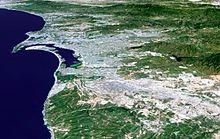
According to SDSU professor emeritus Monte Marshall, San Diego Bay is "the surface expression of a north-south-trending, nested graben". The Rose Canyon and Point Loma fault zones are part of the San Andreas Fault system. About 15 miles east of the bay are the Laguna Mountains in the Peninsular Ranges, which are part of the backbone of the American continents.
The city lies on approximately 200 deep canyons and hills separating its mesas, creating small pockets of natural open space scattered throughout the city and giving it a hilly geography. Traditionally, San Diegans have built their homes and businesses on the mesas, while leaving the urban canyons relatively wild. Thus, the canyons give parts of the city a segmented feel, creating gaps between otherwise proximate neighborhoods and contributing to a low-density, car-centered environment. The San Diego River runs through the middle of San Diego from east to west, creating a river valley which serves to divide the city into northern and southern segments. The river used to flow into San Diego Bay and its fresh water was the focus of the earliest Spanish explorers. Several reservoirs and Mission Trails Regional Park also lie between and separate developed areas of the city.
Notable peaks within the city limits include Cowles Mountain, the highest point in the city at 1,593 feet (486 m); Black Mountain at 1,558 feet (475 m); and Mount Soledad at 824 feet (251 m). The Cuyamaca Mountains and Laguna Mountains rise to the east of the city, and beyond the mountains are desert areas. The Cleveland National Forest is a half-hour drive from downtown San Diego. Numerous farms are found in the valleys northeast and southeast of the city.
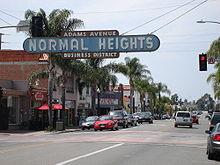
The city of San Diego recognizes 52 individual areas as Community Planning Areas. Within a given planning area there may be several distinct neighborhoods. Altogether the city contains more than 100 identified neighborhoods.
Downtown San Diego is located on San Diego Bay. Balboa Park encompasses several mesas and canyons to the northeast, surrounded by older, dense urban communities including Hillcrest and North Park. To the east and southeast lie City Heights, the College Area, and Southeast San Diego. To the north lies Mission Valley and Interstate 8. The communities north of the valley and freeway, and south of Marine Corps Air Station Miramar, include Clairemont, Kearny Mesa, Tierrasanta, and Navajo. Stretching north from Miramar are the northern suburbs of Mira Mesa, Scripps Ranch, Rancho PeR±asquitos, and Rancho Bernardo. The far northeast portion of the city encompasses Lake Hodges and the San Pasqual Valley, which holds an agricultural preserve. Carmel Valley and Del Mar Heights occupy the northwest corner of the city. To their south are Torrey Pines State Reserve and the business center of the Golden Triangle. Further south are the beach and coastal communities of La Jolla, Pacific Beach, and Ocean Beach. Point Loma occupies the peninsula across San Diego Bay from downtown. The communities of South San Diego, such as San Ysidro and Otay Mesa, are located next to the Mexico ae United States border, and are physically separated from the rest of the city by the cities of National City and Chula Vista. A narrow strip of land at the bottom of San Diego Bay connects these southern neighborhoods with the rest of the city.
For the most part, San Diego neighborhood boundaries tend to be understood by its residents based on geographical boundaries like canyons and street patterns. The city recognized the importance of its neighborhoods when it organized its 2008 General Plan around the concept of a "City of Villages".
San Diego was originally centered in the Old Town district, but by the late 1860s the center of focus had relocated to the bayfront in the belief that this new location would increase trade. As the "New Town" ae present-day Downtown ae waterfront location quickly developed, it eclipsed Old Town as the center of San Diego.
The development of skyscrapers over 300 feet (91 m) in San Diego is attributed to the construction of the El Cortez Apartment Hotel in 1927, the tallest building in the city from 1927 to 1963. As time went on multiple buildings claimed the title of San Diego's tallest skyscraper, including the Union Bank of California Building and Symphony Towers. Currently the tallest building in San Diego is One America Plaza, standing 500 feet (150 m) tall, which was completed in 1991. The downtown skyline contains no super-talls, as a regulation put in place by the Federal Aviation Administration in the 1970s set a 500 feet (152 m) limit on the height of buildings due to the proximity of San Diego International Airport. An iconic description of the skyline includes its skyscrapers being compared to the tools of a toolbox.

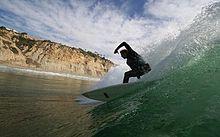
San Diego is one of the top-ten best climates in the Farmer aos Almanac and is one of the two best summer climates in America as scored by The Weather Channel. Under the Koppen climate classification system, the San Diego area straddles areas of Mediterranean climate (Csa) to the north and semi-arid climate (BSh) to the south and east. As a result, it is often described as auarid Mediterranean au and auSemi-arid Steppe au. San Diego aos climate is characterized by warm, dry summers and mild winters with most of the annual precipitation falling between December and March. The city has mild, mostly dry weather, with an average of 201 days above 70 °F (21 °C) and low rainfall (9 ae13 inches [23 ae33 cm] annually).
The climate in San Diego, like most of Southern California, often varies significantly over short geographical distances resulting in microclimates. In San Diego, this is mostly because of the city aos topography (the Bay, and the numerous hills, mountains, and canyons). Frequently, particularly during the auMay gray/June gloom au period, a thick aumarine layer au cloud cover will keep the air cool and damp within a few miles of the coast, but will yield to bright cloudless sunshine approximately 5 ae10 miles (8.0 ae16 km) inland. Sometimes the June gloom can last into July, causing cloudy skies over most of San Diego for the entire day. Even in the absence of June gloom, inland areas tend to experience much more significant temperature variations than coastal areas, where the ocean serves as a moderating influence. Thus, for example, downtown San Diego averages January lows of 50 °F (10 °C) and August highs of 78 °F (26 °C). The city of El Cajon, just 10 miles (16 km) inland from downtown San Diego, averages January lows of 42 °F (6 °C) and August highs of 88 °F (31 °C).
A sign of global warming, scientists at Scripps Institution of Oceanography say the average surface temperature of the water at Scripps Pier in the California Current has increased by almost 3 degrees since 1950.
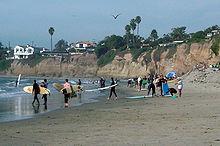
Rainfall along the coast averages about 10 inches (250 mm) of precipitation annually. The average (mean) rainfall is 10.65 inches (271 mm) and the median is 9.6 inches (240 mm). Most of the rainfall occurs during the cooler months. The months of December through March supply most of the rain, with February the only month averaging 2 inches (51 mm) or more of rain. The months of May through September tend to be almost completely dry. Though there are few wet days per month during the rainy period, rainfall can be heavy when it does fall. Rainfall is usually greater in the higher elevations of San Diego; some of the higher elevation areas of San Diego can receive 11 ae15 inches (280 ae380 mm) of rain a year. Variability of rainfall can be extreme: in the wettest years of 1883/1884 and 1940/1941 more than 24 inches (610 mm) fell in the city, whilst in the driest years as little as 3.2 inches (80 mm) has fallen for a full year. The wettest month on record has been December 1921 with 9.21 inches (234 mm).
Snow in the city is so rare that it has been observed only five times in the century-and-a-half that records have been kept. In 1949 and 1967, snow stayed on the ground for a few hours in higher locations like Point Loma and La Jolla. The other three occasions, in 1882, 1946, and 1987, involved flurries but no accumulation.
Official temperature record-keeping began in San Diego in 1872, although other weather records go back further. The city's first official weather station was at Mission San Diego from 1849 to 1858. From August 1858 until 1940, the official weather station was at a series of downtown buildings, and the station has been at Lindbergh Field since February 1940.
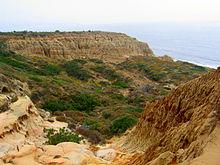
Like most of southern California, the majority of San Diego's current area was originally occupied by chaparral, a plant community made up mostly of drought-resistant shrubs. The endangered Torrey Pine has the bulk of its population in San Diego in a stretch of protected chaparral along the coast. The steep and varied topography and proximity to the ocean create a number of different habitats within the city limits, including tidal marsh and canyons. The chaparral and coastal sage scrub habitats in low elevations along the coast are prone to wildfire, and the rates of fire have increased in the 20th century, due primarily to fires starting near the borders of urban and wild areas.
San Diego's broad city limits encompass a number of large nature preserves, including Torrey Pines State Reserve, Los PeR±asquitos Canyon Preserve, and Mission Trails Regional Park. Torrey Pines State Reserve and a coastal strip continuing to the north constitute the only location where the rare species of Torrey Pine, P. torreyana torreyana, is found.
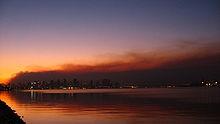
Due to the steep topography that prevents or discourages building, along with some efforts for preservation, there are also a large number of canyons within the city limits that serve as nature preserves, including Switzer Canyon, Tecolote Canyon Natural Park, and Marian Bear Memorial Park in the San Clemente Canyon, as well as a number of small parks and preserves.
San Diego County has one of the highest counts of animal and plant species that appear on the endangered species list among counties in the United States. Because of its diversity of habitat and its position on the Pacific Flyway, San Diego County has recorded the presence of 492 bird species, more than any other region in the country. San Diego always scores very high in the number of bird species observed in the annual Christmas Bird Count, sponsored by the Audubon Society, and it is known as one of the "birdiest" areas in the United States.
San Diego and its backcountry are subject to periodic wildfires. In October 2003, San Diego was the site of the Cedar Fire, which has been called the largest wildfire in California over the past century. The fire burned 280,000 acres (1,100 km2), killed 15 people, and destroyed more than 2,200 homes. In addition to damage caused by the fire, smoke resulted in a significant increase in emergency room visits due to asthma, respiratory problems, eye irritation, and smoke inhalation; the poor air quality caused San Diego County schools to close for a week. Wildfires four years later destroyed some areas, particularly within the communities of Rancho Bernardo, Rancho Santa Fe, and Ramona.
The city had a population of 1,307,402 in 2010, according to the census that year, on a land area of 372.1 square miles (963.7 km2). The urban area of San Diego extends beyond the administrative city limits and had a total 2010 population of 2,880,000, making it the third-largest urban area in the state, after Los Angeles metropolitan area and San Francisco metropolitan area.
As of the Census of 2010, there were 1,307,402 people living in the city of San Diego. That represents a population increase of just under 7% from the 1,223,400 people, 450,691 households, and 271,315 families reported in 2000. The estimated city population in 2009 was 1,306,300. The population density was 3,771.9 people per square mile (1,456.4/km2). The racial makeup of San Diego was 58.9% White, 6.7% African American, 0.6% Native American, 15.9% Asian (5.9% Filipino, 2.7% Chinese, 2.5% Vietnamese, 1.3% Indian, 1.0% Korean, 0.7% Japanese, 0.4% Laotian, 0.3% Cambodian, 0.1% Thai). 0.5% Pacific Islander, 12.3% from other races, and 5.1% from two or more races. Hispanic or Latino of any race were 28.8%. Among the Hispanic population, 24.9% are Mexican, and 0.6% are Puerto Rican.

As of January 1, 2008 estimates by the San Diego Association of Governments revealed that the household median income for San Diego rose to $66,715, up from $45,733, and that the city population rose to 1,336,865, up 9.3% from 2000. The population was 45.3% non-Hispanic whites, down from 78.9% in 1970, 27.7% Hispanics, 15.6% Asians/Pacific Islanders, 7.1% blacks, 0.4% American Indians, and 3.9% from other races. Median age of Hispanics was 27.5 years, compared to 35.1 years overall and 41.6 years among non-Hispanic whites; Hispanics were the largest group in all ages under 18, and non-Hispanic whites constituted 63.1% of population 55 and older.
In 2000 there were 451,126 households out of which 30.2% had children under the age of 18 living with them, 44.6% were married couples living together, 11.4% had a female householder with no husband present, and 39.8% were non-families. Households made up of individuals account for 28.0% and 7.4% had someone living alone who was 65 years of age or older. The average household size was 2.61 and the average family size was 3.30.
The U.S. Census Bureau reported that in 2000, 24.0% of San Diego residents were under 18, and 10.5% were 65 and over. The median age was 32; two-thirds of the population was under 35. The San Diego County regional planning agency, SANDAG, provides tables and graphs breaking down the city population into 5-year age groups. In 2000, the median income for a household in the city was $45,733, and the median income for a family was $53,060. Males had a median income of $36,984 versus $31,076 for females. The per capita income for the city was $23,609. According to Forbes in 2005, San Diego was the fifth wealthiest U.S. city but about 10.6% of families and 14.6% of the population were below the poverty line, including 20.0% of those under age 18 and 7.6% of those age 65 or over. Nonetheless, San Diego was rated the fifth-best place to live in the United States in 2006 by Money magazine.
According to Forbes magazine, San Diego was the ninth-safest city in the top 10 list of safest cities in the U.S. in 2010. Like most major cities, San Diego had a declining crime rate from 1990 to 2000. Crime in San Diego increased in the early 2000s. In 2004, San Diego had the sixth lowest crime rate of any U.S. city with over half a million residents. From 2002 to 2006, the crime rate overall dropped 0.8%, though not evenly by category. While violent crime decreased 12.4% during this period, property crime increased 1.1%. Total property crimes per 100,000 people were lower than the national average in 2008.
The largest sectors of San Diego's economy are defense/military, tourism, international trade, and research/manufacturing, respectively.
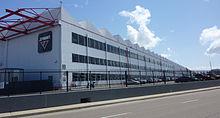
The economy of San Diego is influenced by its deepwater port, which includes the only major submarine and shipbuilding yards on the West Coast. Several major national defense contractors were started and are headquartered in San Diego, including General Atomics, Cubic, and NASSCO.
San Diego hosts the largest naval fleet in the world: it was in 2008 was home to 53 ships, over 120 tenant commands, and more than 35,000 sailors, soldiers, Department of Defense civilian employees and contractors. About 5 percent of all civilian jobs in the county are military-related, and 15,000 businesses in San Diego County rely on Department of Defense contracts.
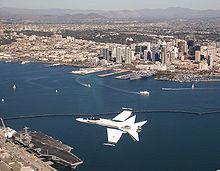
Military bases in San Diego include US Navy facilities, Marine Corps bases, and Coast Guard stations. Marine Corps institutions in the city of San Diego include Marine Corps Air Station Miramar and Marine Corps Recruit Depot San Diego. The Navy has several institutions in the city, including Naval Base Point Loma, Naval Base San Diego (also known as the 32nd Street Naval Station), Naval Medical Center San Diego (also known as Bob Wilson Naval Hospital), the Space and Naval Warfare Systems Center San Diego, and Space and Naval Warfare Systems Command ("SPAWAR"). Also near San Diego but not within the city limits are Naval Amphibious Base Coronado and Naval Air Station North Island (which operates Naval Auxiliary Landing Facility San Clemente Island, Silver Strand Training Complex, and the Outlying Field Imperial Beach). San Diego is known as the "birthplace of naval aviation".
The city is "home to the majority of the U.S. Pacific Fleet's surface combatants, all of the Navy's West Coast amphibious ships and a variety of Coast Guard and Military Sealift Command vessels". Two Nimitz class supercarriers, (the USS Carl Vinson, and USS Ronald Reagan), five amphibious assault ships, several Los Angeles-class "fast attack" submarines, the Hospital Ship USNS Mercy, carrier and submarine tenders, destroyers, cruisers, frigates, and many smaller ships are home-ported there. Four Navy vessels have been named USS San Diego.
Tourism is a major industry owing to the city's climate, its beaches, and numerous tourist attractions such as Balboa Park, Belmont amusement park, San Diego Zoo, San Diego Zoo Safari Park, and SeaWorld San Diego. San Diego's Spanish and Mexican heritage is reflected in the many historic sites across the city, such as Mission San Diego de Alcala and Old Town San Diego State Historic Park. Annual events in San Diego include Comic-Con, the Farmers Insurance Open golf tournament, San Diego Pride, the San Diego Black Film Festival, and Street Scene Music Festival. Also, the local craft brewing industry attracts an increasing number of visitors for "beer tours" and the annual San Diego Beer Week in November; San Diego has been called "America's Craft Beer Capital."
San Diego County hosted more than 30 million visitors in 2009, of whom approximately half stayed overnight and half were day visitors; collectively they spent an estimated $15 billion locally. The San Diego Convention Center hosted 68 out-of-town conventions and trade shows in 2009, attracting more than 600,000 visitors. Transient Occupancy Taxes (TOT) have created funding for the City of San Diego Commission for Arts and Culture.
San Diego's cruise ship industry used to be the second largest in California. Each cruise ship call injects an estimated $2 million (from the purchase of food, fuel, supplies, and maintenance services, not counting the money spent by the tourists) into the local economy. Numerous cruise lines, including Carnival, Holland America, Celebrity, Crystal and Princess, operate out of San Diego. However, cruise ship business has been in steady decline since peaking in 2008, when the Port hosted over 250 ship calls and more than 900,000 passengers. By 2011 the number of ship calls had fallen to 103 (estimated).[100] Holland America and Carnival Cruises operated weekly cruises to the Mexican Riviera for many years, but both ended their regular scheduled service in spring 2012, which was an economic loss to the region of more than $100 million.[100] The decline is blamed on the slumping economy as well as fear of travel to Mexico due to well-publicized violence there.[101]
There are local cruises in San Diego Bay and Mission Bay, available through companies such as Hornblower and H&M. These include sightseeing and "sunset" cruises as well as private-event or "party" cruises. Also available are whale watching cruises to observe the migration of tens of thousands of gray whales that pass by San Diego, peaking in mid-January,[102] and year-round sport fishing expeditions.
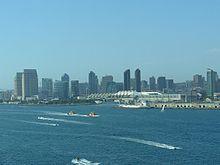
San Diego's commercial port and its location on the United States-Mexico border make international trade an important factor in the city's economy. The city is authorized by the United States government to operate as a Foreign Trade Zone.[103]
The city shares a 15-mile (24 km) border with Mexico that includes two border crossings. San Diego hosts the busiest international border crossing in the world, in the San Ysidro neighborhood at the San Ysidro Port of Entry.[104] A second, primarily commercial border crossing operates in the Otay Mesa area; it is the largest commercial crossing on the California-Baja California border and handles the third highest volume of trucks and dollar value of trade among all United States-Mexico land crossings.[105]
One of the Port of San Diego's two cargo facilities is located in Downtown San Diego at the Tenth Avenue Marine Terminal. This terminal has facilities for containers, bulk cargo, and refrigerated and frozen storage, so that it can handle the import and export of perishables (including 33 million bananas every month) as well as fertilizer, cement, forest products, and other commodities.[106] In 2009 the Port of San Diego handled 1,137,054 short tons of total trade; foreign trade accounted for 956,637 short tons while domestic trade amounted to 180,417 short tons.[107]
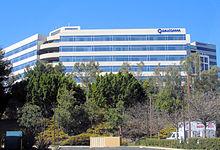
In 2010, former Governor Schwarzenegger aos Office of Economic Development designated San Diego as an iHub Innovation Center for collaboration potentially between wireless and life sciences, citing the area's wireless business, pharmaceutical research and start-ups for medical devices and diagnostics.[108]
San Diego hosts several major producers of wireless cellular technology. Qualcomm was founded and is headquartered in San Diego, and still is the largest private-sector technology employer (excluding hospitals) in San Diego County.[109] Other wireless industry manufacturers headquartered here include Nokia, LG Electronics,[110] Kyocera International.,[111] Cricket Communications and Novatel Wireless.[112] According to the San Diego Business Journal, the largest software company in San Diego is security software company Websense Inc.[113] San Diego also has the U.S. headquarters for the Slovakian security company ESET.[114]
The presence of the University of California, San Diego and other research institutions has helped to fuel biotechnology growth.[115] In June 2004, San Diego was ranked the top biotech cluster in the United States by the Milken Institute.[116] There are more than 400 biotechnology companies in the area.[117] In particular, the La Jolla and nearby Sorrento Valley areas are home to offices and research facilities for numerous biotechnology companies.[118] Major biotechnology companies like Neurocrine Biosciences and Nventa Biopharmaceuticals are headquartered in San Diego, while many biotech and pharmaceutical companies, such as BD Biosciences, Biogen Idec, Integrated DNA Technologies, Merck, Pfizer, Rolan, Celgene, and Vertex, have offices or research facilities in San Diego. There are also several non-profit biotech and health care institutes, such as the Salk Institute for Biological Studies, the Scripps Research Institute, the West Wireless Health Institute and the Sanford-Burnham Institute. San Diego is also home to more than 140 contract research organizations (CROs) that provide a variety of contract services for pharmaceutical and biotechnology companies.[119]
Historically tuna fishing and canning was one of San Diego's major industries,[120] and although the American tuna fishing fleet is no longer based in San Diego, seafood companies Bumble Bee Foods and Chicken of the Sea are still headquartered there.

Prior to 2006, San Diego experienced a dramatic growth of real estate prices, to the extent that the situation was sometimes described as a "housing affordability crisis". Median single family home prices more than tripled between 1998 and 2007. According to the California Association of Realtors, in May 2007 a median house in San Diego cost $612,370.[121] Growth of real estate prices was not accompanied by comparable growth of household incomes: the Housing Affordability Index (percentage of households that can afford to buy a median-priced house) fell below 20 percent in the early 2000s. The San Diego metropolitan area had one of the worst median multiples (ratio of median house price to median household income) of all metropolitan areas in the United States[122], a situation sometimes referred to as a Sunshine tax. As a consequence, San Diego experienced negative net migration since 2004. A significant number of people moved to adjacent Riverside County, commuting daily from Temecula and Murrieta to jobs in San Diego. Many of San Diego's home buyers tend to buy homes within the more affordable neighborhoods, while others are leaving the state altogether and moving to more affordable regions of the country.[123]
San Diego home prices peaked in 2005, then declined as part of a nationwide trend. As of December 2010, home prices were 60 percent higher than in 2000, but down 36 percent from the peak in 2005.[124] The median home price declined by more than $200,000 between 2005 and 2010, and sales dropped by 50 percent.[125]
According to the City's 2011 Comprehensive Annual Financial Report,[126] the top employers in the city are:
Public schools in San Diego are operated by independent school districts. The majority of the public schools in the city are served by the San Diego Unified School District, also the second largest school district in California, which includes 11 K-8 schools, 107 elementary schools, 24 middle schools, 13 atypical and alternative schools, 28 high schools, and 45 charter schools.[127] Several adjacent school districts which are headquartered outside the city limits serve some schools within the city; these include the Poway Unified School District, Del Mar Union School District, San Dieguito Union High School District and Sweetwater Union High School District. In addition, there are a number of private schools in the city.
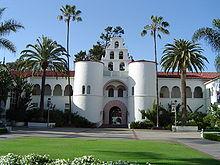
According to education rankings released by the U.S. Census Bureau, 40.4 percent of San Diegans ages 25 and older hold bachelor's degrees. The census ranks the city as the ninth most educated city in the United States based on these figures.[128]
Public colleges and universities in the city include San Diego State University (SDSU), University of California, San Diego (UCSD), and the San Diego Community College District, which includes San Diego City College, San Diego Mesa College, and San Diego Miramar College. Private colleges and universities in the city include University of San Diego (USD), Point Loma Nazarene University (PLNU), Alliant International University (AIU), National University, California International Business University (CIBU), San Diego Christian College, John Paul the Great Catholic University, California College San Diego, Coleman University, University of Redlands School of Business, Design Institute of San Diego (DISD), Fashion Institute of Design & Merchandising's San Diego campus, NewSchool of Architecture and Design, Pacific Oaks College San Diego Campus, Chapman University's San Diego Campus, The Art Institute of California-San Diego, Southern States University (SSU), UEI College, and Woodbury University School of Architecture's satellite campus.
There is one medical school in the city, the UCSD School of Medicine. There are three ABA accredited law schools in the city, which include California Western School of Law, Thomas Jefferson School of Law, and University of San Diego School of Law. There is also one unaccredited law school, Western Sierra Law School.
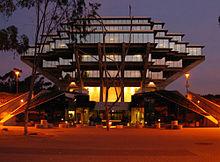
The city-run San Diego Public Library system is headquartered downtown and has 34 branches throughout the city.[129] The libraries have had reduced operating hours since 2003 due to the city's financial problems. In 2006 the city increased spending on libraries by $2.1 million.[130] A new nine-story Central Library is under construction on Park Boulevard at J Street.[131]
In addition to the municipal public library system, there are nearly two dozen libraries open to the public which are run by other governmental agencies and by schools, colleges, and universities.[132] Noteworthy among them are the Malcolm A. Love Library at San Diego State University and the Geisel Library at the University of California, San Diego.
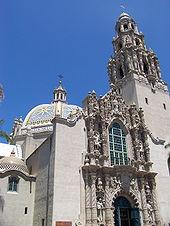
Many popular museums, such as the San Diego Museum of Art, the San Diego Natural History Museum, the San Diego Museum of Man, and the Museum of Photographic Arts are located in Balboa Park. The Museum of Contemporary Art San Diego (MCASD) is located in La Jolla and has a branch located at the Santa Fe Depot downtown. The Columbia district downtown is home to historic ship exhibits belonging to the San Diego Maritime Museum, headlined by the Star of India, as well as the unrelated San Diego Aircraft Carrier Museum featuring the USS Midway aircraft carrier.
The San Diego Symphony at Symphony Towers performs on a regular basis and is directed by Jahja Ling. The San Diego Opera at Civic Center Plaza, directed by Ian Campbell, was ranked by Opera America as one of the top 10 opera companies in the United States. Old Globe Theatre at Balboa Park produces about 15 plays and musicals annually. The La Jolla Playhouse at UCSD is directed by Christopher Ashley. Both the Old Globe Theatre and the La Jolla Playhouse have produced the world premieres of plays and musicals that have gone on to win Tony Awards[133] or nominations[134] on Broadway. The Joan B. Kroc Theatre at Kroc Center's Performing Arts Center is a 600-seat state-of-the-art theatre that hosts music, dance, and theatre performances. The San Diego Repertory Theatre at the Lyceum Theatres in Horton Plaza produces a variety of plays and musicals. Other professional theatrical production companies include the Lyric Opera San Diego and the Starlight Musical Theatre. Hundreds of movies and a dozen TV shows have been filmed in San Diego, a tradition going back as far as 1898.[135]
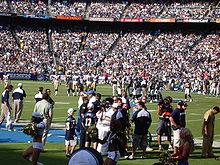
The National Football League's San Diego Chargers play in Qualcomm Stadium. Three NFL Super Bowl championships have been held there. Major League Baseball's San Diego Padres play in Petco Park. Parts of the World Baseball Classic were played there in 2006 and 2009.
NCAA Division I San Diego State Aztecs men's and women's basketball games are played at Viejas Arena at Aztec Bowl on the campus of San Diego State University. College football and soccer, basketball and volleyball are played at the Torero Stadium and the Jenny Craig Pavilion at USD.
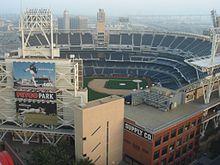
The San Diego State Aztecs (MWC) and the University of San Diego Toreros (WCC) are NCAA Division I teams. The UCSD Tritons (CCAA) are members of NCAA Division II while the Point Loma Nazarene Sea Lions and San Diego Christian College (GSAC) are members of the NAIA.
Qualcomm stadium also houses the NCAA Division I San Diego State Aztecs, as well as local high school football championships, international soccer games, and supercross events. Two of college football's annual bowl games are also held there: the Holiday Bowl and the Poinsettia Bowl. Soccer, American football, and track and field are played in Balboa Stadium, the city's first stadium, constructed in 1914.
Rugby union is a developing sport in the city. The USA Sevens, a major rugby event, was held there from 2007 through 2009. San Diego is one of only 16 cities in the United States included in the Rugby Super League[136] represented by Old Mission Beach Athletic Club RFC, the home club of USA Rugby's Captain Todd Clever who plays rugby professionally in Japan's Top League with Suntory Sungoliath.[137] San Diego will participate in the Western American National Rugby League which starts in 2011.[138]
The San Diego Surf of the American Basketball Association is located in the city. The annual Farmers Insurance Open golf tournament (formerly the Buick Invitational) on the PGA Tour occurs at the municipally owned Torrey Pines Golf Course. This course was also the site of the 2008 U.S. Open Golf Championship. The San Diego Yacht Club hosted the America's Cup yacht races three times during the period 1988 to 1995. The amateur beach sport Over-the-line was invented in San Diego,[139] and the annual world Over-the-line championships are held at Mission Bay every year.[140]
The following are published within the city: the daily newspaper, U-T San Diego and its online portal, of the same name,[141] and the alternative newsweeklies, the San Diego CityBeat and San Diego Reader. Another newspaper is the North County Times, which is distributed in San Diego's North County area. Voice of San Diego is a non-profit online-only news outlet covering government, politics, education, neighborhoods, and the arts. The San Diego Daily Transcript is a business-oriented daily newspaper.
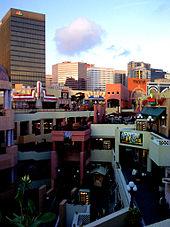
San Diego led U.S. local markets with 69.6 percent broadband penetration in 2004 according to Nielsen//NetRatings.[142]
San Diego's first television station was KFMB, which began broadcasting on May 16, 1949.[143] Since the Federal Communications Commission (FCC) licensed seven television stations in Los Angeles, two VHF channels were available for San Diego because of its relative proximity to the larger city. In 1952, however, the FCC began licensing UHF channels, making it possible for cities such as San Diego to acquire more stations. Stations based in Mexico (with ITU prefixes of XE and XH) also serve the San Diego market. Television stations today include XHTJB 3 (Once TV), XETV 6 (CW), KFMB 8 (CBS), KGTV 10 (ABC), XEWT 12 (Televisa Regional), KPBS 15 (PBS), KTCD-CA 17 (Univision), XHTIT 21 (Azteca 7), XHJK 27 (Azteca 13), KSDX-LP 29 (Spanish Independent), XHAS 33 (Telemundo), K35DG 35 (UCSD-TV), KBNT-LD 51 (Telefutura), KNSD 39 (NBC), KZSD-LP 41 (Azteca America), KSEX-CD 42 (Infomercials), XHBJ 45 (Canal 5), XHDTV 49 (MNTV), KUSI 51 (Independent), XHUAA 57 (Canal de las Estrellas), and KSWB-TV 69 (Fox). San Diego has an 80.6 percent cable penetration rate.[144]
Due to the ratio of U.S. and Mexican-licensed stations, San Diego is the largest media market in the United States that is legally unable to support a television station duopoly between two full-power stations under FCC regulations, which disallow duopolies in metropolitan areas with fewer than nine full-power television stations and require that there must be eight unique station owners that remain once a duopoly is formed (there are only seven full-power stations on the California side of the San Diego-Tijuana market). Though the E. W. Scripps Company owns KGTV and KZSD-LP, they are not considered a duopoly under the FCC's legal definition as common ownership between full-power and low-power television stations in the same market is permitted regardless to the number of stations licensed to the area. As a whole, the Mexico side of the San Diego-Tijuana market has two duopolies and one triopoly (Entravision Communications owns both XHAS-TV and XHDTV-TV, TV Azteca owns XHJK-TV and XHTIT-TV, and Grupo Televisa owns XHUAA-TV and XHWT-TV along with being the license holder for XETV-TV, which is run by California-based subsidiary Bay City Television).
The radio stations in San Diego include nationwide broadcaster, Clear Channel Communications; CBS Radio, Midwest Television, Lincoln Financial Media, Finest City Broadcasting, and many other smaller stations and networks. Stations include: KOGO AM 600, KFMB AM 760, KCEO AM 1000, KCBQ AM 1170, K-Praise, KLSD AM 1360 Air America, KFSD 1450 AM, KPBS-FM 89.5, Channel 933, Star 94.1, FM 94/9, FM News and Talk 95.7, Q96 96.1, KyXy 96.5, Free Radio San Diego (AKA Pirate Radio San Diego) 96.9FM FRSD, KSON 97.3/92.1, KIFM 98.1, Jack-FM 100.7, 101.5 KGB-FM, KPRI 102.1, Rock 105.3, and another Pirate Radio station at 106.9FM, as well as a number of local Spanish-language radio stations.
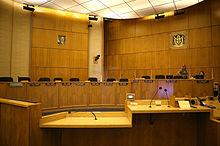
The city is governed by a mayor and an 8-member city council. In 2006, the city's form of government changed from a "city manager system" to a "strong mayor system". The change was brought about by a citywide vote in 2004. The mayor is in effect the chief executive officer of the city, while the council is the legislative body.[145]
The members of the city council are each elected from single member districts within the city. The mayor and city attorney are elected directly by the voters of the entire city. The mayor, city attorney, and council members are elected to four-year terms, with a two-term limit.[146] Elections are held on a non-partisan basis per California state law; nevertheless, most officeholders do identify themselves as either Democrats or Republicans.
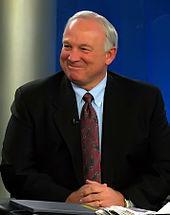
Although San Diego has a Republican mayor,[147] in 2007, registered Democrats outnumbered Republicans by about 7 to 6 in the city, and Democrats currently hold a 5 ae3 majority in the City Council.[148]
San Diego is part of San Diego County which is governed by a 5-member Board of Supervisors. The City of San Diego includes all or part of the 1st, 2nd, 3rd and 4th supervisorial[149] districts, represented by Republican County Supervisors Greg Cox, Dianne Jacob, Pam Slater-Price and Ron Roberts.[150]
Areas of the city immediately adjacent to San Diego Bay ("tidelands") are administered by the Port of San Diego, a quasi-governmental agency which owns all the property in the tidelands and is responsible for its land use planning, policing, and similar functions. San Diego is a member of the regional planning agency San Diego Association of Governments (SANDAG). Public schools within the city are managed and funded by independent school districts (see above).
In the state legislature San Diego is located in the 36th, 38th, 39th, and 40th Senate District, represented by Republicans Joel Anderson and Mark Wyland, and Democrats Christine Kehoe and Juan Vargas, and in the 74th, 75th, 76th, 77th, 78th, and 79th Assembly District, represented by Republicans Martin Garrick and Nathan Fletcher, Democrat Toni Atkins, Republican Brian Jones and Democrats Marty Block and Ben Hueso, respectively.
Federally, San Diego is located in California's 49th, 50th, 51st, 52nd, and 53rd congressional districts, which have Cook PVIs of R +10, R +5, D +7, R +9, and D +12 respectively[151] and are represented by Republicans Darrell Issa and Brian Bilbray, Democrat Bob Filner, Republican Duncan D. Hunter, and Democrat Susan Davis, respectively.
In 1916, rainmaker Charles Hatfield was blamed for $4 million in damages and accused of causing San Diego's worst flood, during which about twenty Japanese American farmers died.[152]
Then-mayor Roger Hedgecock was forced to resign his post in 1985, after he was found guilty of one count of conspiracy and twelve counts of perjury, related to the alleged failure to report all campaign contributions.[153][154] After a series of appeals, the twelve perjury counts were dismissed in 1990 based on claims of juror misconduct; the remaining conspiracy count was reduced to a misdemeanor and then dismissed.[155]
A 2002 scheme to underfund pensions for city employees led to the San Diego pension scandal. This resulted in the resignation of newly re-elected Mayor Dick Murphy[156] and the criminal indictment of six pension board members.[157] Those charges were finally dismissed by a federal judge in 2010.[158]
On November 28, 2005, U.S. Congressman Randy "Duke" Cunningham resigned after being convicted on federal bribery charges. He had represented California's 50th congressional district, which includes much of the northern portion of the city of San Diego. In 2006, Cunningham was sentenced to a 100-month prison sentence.[159]
In 2005 two city council members, Ralph Inzunza and Deputy Mayor Michael Zucchet ae who briefly took over as Acting Mayor when Murphy resigned ae were convicted of extortion, wire fraud, and conspiracy to commit wire fraud for taking campaign contributions from a strip club owner and his associates, allegedly in exchange for trying to repeal the city's "no touch" laws at strip clubs.[160] Both subsequently resigned. In 2009, a judge acquitted Zucchet on seven out of the nine counts against him, and granted his petition for a new trial on the other two charges;[161] the remaining charges were eventually dropped.[162]
Water is supplied to residents by the Water Department of the City of San Diego. The city receives its water from the Metropolitan Water District of Southern California.
Gas and electric utilities are provided by San Diego Gas & Electric, a division of Sempra Energy.
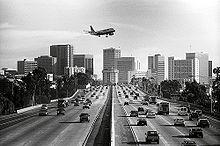
With the automobile being the primary means of transportation for over 80 percent of its residents, San Diego is served by a network of freeways and highways. This includes Interstate 5, which runs south to Tijuana and runs north to Los Angeles; Interstate 8, which runs east to Imperial County and the Arizona Sun Corridor; Interstate 15, which runs northeast through the Inland Empire to Las Vegas; and Interstate 805, which splits from I-5 near the Mexican border and rejoins I-5 at Sorrento Valley.
Major state highways include SR 94, which connects downtown with I-805, I-15 and East County; SR 163, which connects downtown with the northeast part of the city, intersects I-805 and merges with I-15 at Miramar; SR 52, which connects La Jolla with East County through Santee and SR 125; SR 56, which connects I-5 with I-15 through Carmel Valley and Rancho PeR±asquitos; SR 75, which spans San Diego Bay as the San Diego-Coronado Bridge, and also passes through South San Diego as Palm Avenue; and SR 905, which connects I-5 and I-805 to the Otay Mesa Port of Entry.
The stretch of SR 163 that passes through Balboa Park is San Diego's oldest freeway, and has been called one of America's most beautiful parkways.[163]
San Diego's roadway system provides an extensive network of routes for travel by bicycle. The dry and mild climate of San Diego makes cycling a convenient and pleasant year-round option. At the same time, the city's hilly, canyon-like terrain and significantly long average trip distances aebrought about by strict low-density zoning laws aesomewhat restrict cycling for utilitarian purposes. Older and denser neighborhoods around the downtown tend to be utility cycling oriented. This is partly because of the grid street patterns now absent in newer developments farther from the urban core, where suburban style arterial roads are much more common. As a result, a vast majority of cycling-related activities are recreational. Testament to San Diego's cycling efforts, in 2006, San Diego was rated as the best city for cycling for U.S. cities with a population over 1 million.[164]
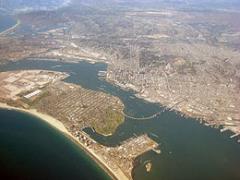
San Diego is served by the trolley, bus, Sprinter, Coaster, and Amtrak. The trolley primarily serves downtown and surrounding urban communities, Mission Valley, east county, and coastal south bay. A planned Mid-Coast line will operate from Old Town to University City along the 5 Freeway. The Amtrak and Coaster trains currently run along the coastline and connect San Diego with Los Angeles, Orange County, Riverside, San Bernardino, and Ventura via Metrolink. There are two Amtrak stations in San Diego, in Old Town and Downtown. San Diego transit information about public transportation and commuting is available on the Web and by dialing "511" from any phone in the area.[165][166]
The city's primary commercial airport is the San Diego International Airport (SAN), also known as Lindbergh Field. It is the busiest single-runway airport in the United States.[167] It served over 17 million passengers in 2005, and is dealing with an increasingly larger number every year.[167] It is located on San Diego Bay three miles (4.8 km) from downtown. San Diego International Airport maintains scheduled flights to the rest of the United States including Hawaii, as well as to Mexico, Canada and the United Kingdom. It is operated by an independent agency, the San Diego Regional Airport Authority. In addition, the city itself operates two general-aviation airports, Montgomery Field (MYF) and Brown Field (SDM).[168]
Several regional transportation projects have been undertaken in recent years to deal with congestion in San Diego. Notable efforts are on San Diego freeways, San Diego Airport, and the cruise terminal of the port. Freeway projects included expansion of Interstates 5 and 805 around "The Merge," a rush-hour spot where the two freeways meet. Also, an expansion of Interstate 15 through the North County is underway with the addition of high-occupancy-vehicle (HOV) "managed lanes". There is a tollway (The South Bay Expressway) connecting SR 54 and Otay Mesa, near the Mexican border. According to a 2007 assessment, 37 percent of streets in San Diego were in acceptable driving condition. The proposed budget fell $84.6 million short of bringing the city's streets to an acceptable level.[169] Port expansions included a second cruise terminal on Broadway Pier which opened in 2010. Airport projects include expansion of Terminal 2, currently under construction and slated for completion in 2013.[170]
San Diego has 16 sister cities, as designated by Sister Cities International:[171][172]




Word Count: 9273






